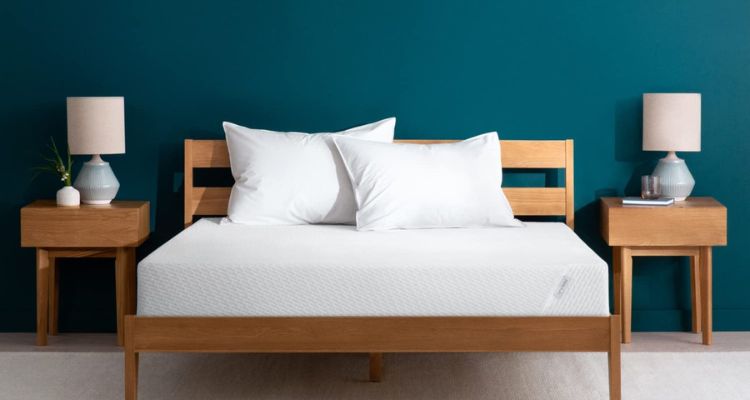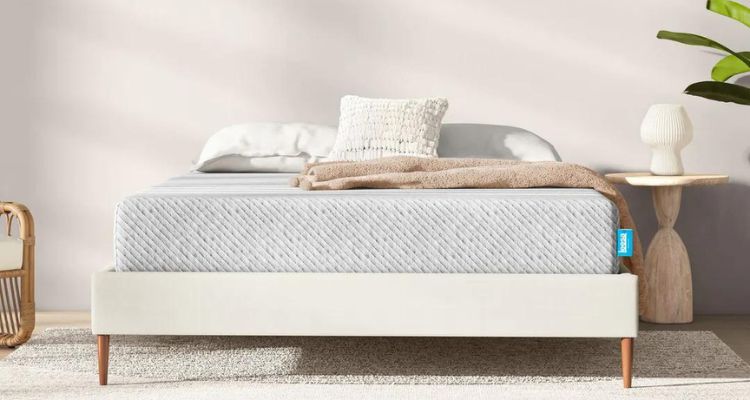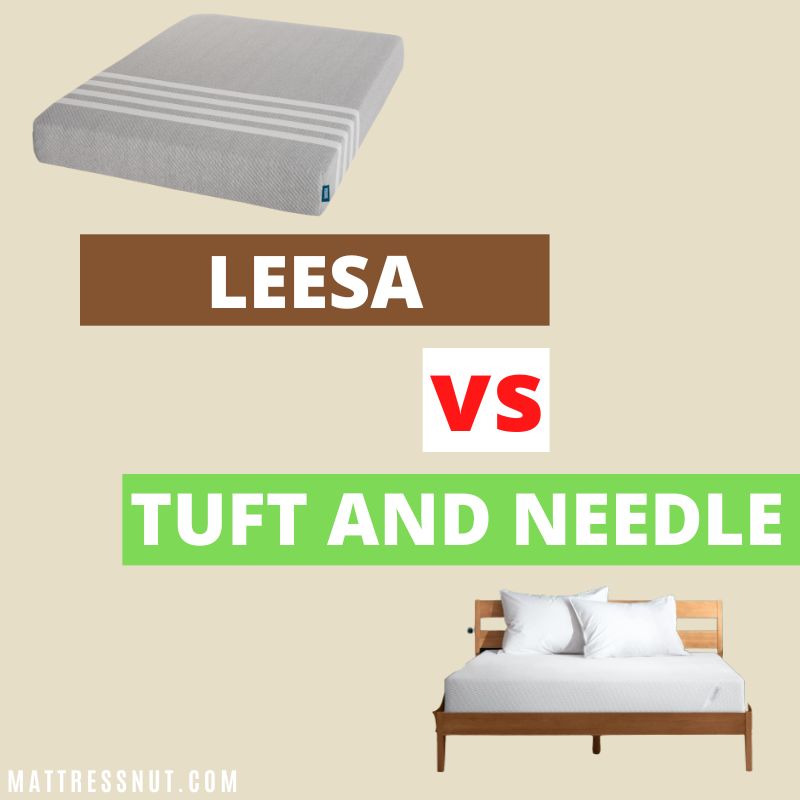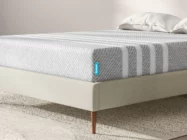If you have narrowed your research to the Leesa and Tuft and Needle mattresses, this review will help you make your decision easier. Both Leesa and Tuft and Needle use proprietary material to comfort the sleeper, they make sure to offer comfortable mattresses to all sleepers. The Tuft and Needle have a straightforward two-layer approach, whereas the Leesa uses three foam layers to give you more transition.
This review compares the different aspects of these mattresses so that you can make a better, well-informed decision for your sleep (also check 10 amazing mattresses).
Comparison Table – Leesa Mattress Vs Tuft and Needle
| Leesa Original Mattress | Tuft Needle Mattress | |
| Best for | Back Sleepers | Side Sleepers |
| Trial Period | 100 night’s sleep trial | 100 night’s sleep trial |
| Warranty | 10-year warranty | 10-year warranty |
| Price range | $849 – $1399 | $745 – $1395 |
The Key Differences Between Leesa and Tuft Vs Needle
Who The Leesa Mattress Is Best For
Best for…
Back sleepers and side sleepers: It provides a good balance of comfort and support for back sleeping and some nice pressure relief for side sleeping (check 10 great mattresses for back pain).
People who don’t like to feel stuck in their mattresses: If you are looking for a foam mattress but hate that feeling of being stuck in one place and finding it difficult to move around, you should consider the Leesa mattress. LSA 200 foam is very responsive and makes it easy to move around on the mattress.
Hot sleepers: If you want an all-foam mattress that does not overheat at night, you should look at the Leesa. The top layer of LSA 200 foam is breathable, has open cell technology, and does not trap too much heat (check the top rated cooling mattresses for hot sleepers).
Who The Leesa Mattress Is Not Best For
Maybe not best for…
Stomach Sleepers: If you are a stomach sleeper, this might not be your best choice (check 10 best selling mattresses for stomach sleepers). This is medium in terms of firmness, and stomach sleepers usually want something that is much firmer to get the proper amount of support under their hips.
If you are looking for a very soft or substantial mattress: If this is what you are looking for, then the Leesa might not be the best choice for you. This is more medium in terms of firmness, so you won’t get that extra plushy or firm feel (also check 10 top-quality plush mattresses).
Those you prefer the classic slow-moving foam: This has poly foam that is very quick to respond, so if you are looking for that classic slow-moving memory foam layer, feel you should look elsewhere.
Who The Tuft And Needle Mattress Is Best For
Best for…
Those who want a good deal: The Tuft and Needle mattress is economically priced and has good deals, especially on the queen-sized mattress, making it a good option for value shoppers.
Light and medium weight combo sleepers: It is also a good match for light and medium weight combination sleepers. The Tuft and Needle is an incredible option if you are light and medium weight and like changing positions at night.
Those who prefer a balanced foam feel: If you like to sink into your mattress a bit, but it does not make it hard to move around at night, this is a great option.
Who The Tuft And Needle Mattress Is Not Best For
Maybe not best for…
Stomach sleepers: this will be a constant for all soft mattresses. If you are a stomach sleeper, you need something on the firmer side.
Heavier sleepers: If you are 250 pounds or more, you will want to look for a more substantial mattress (also check 10 great mattresses for overweight people). Possibly with coils in the support layer.
Top Features compared – Leesa Vs. Casper Mattress
Construction
The Tuft and Needle is an all-foam mattress of two different layers. It stands 10 inches in height, and the cover is made of a polyester blend. It is pretty thin and breathable. The comfort layer on the top is the one you will feel most. It is three inches of proprietary Tuft and Needle foam. This poly foam, also known as adaptive foam, quickly responds to pressure.

It is also infused with ceramic gel and graphite cooling technology. Both help with cooling and heat dissipation as foam mattresses are known to trap body heat, so you need something to counter that. Below that, you have a standard base support foam. These materials make this mattress a streamlined value mattress that gives you comfort without breaking your bank balance.
The Leesa mattresses, on the other hand, has a three-layer approach. Standing 10 inches tall (the same height as the Tuft and Needle mattress), this mattress is constructed to give you the ultimate comfort. Starting with the cover, it is a twill fabric that is also soft and breathable. Therefore, it should not affect the overall feel of the mattress too much. The top layer is a proprietary LSA 200 foam.
This is a very promising and comfortable foam that, too, is very responsive. It also has open cell technology that helps with cooling and breathability on the top of the mattress. Below that, you get two inches of standard memory foam with the classic slow-move feel.
And lastly, you get 6 inches of poly base support foam. Again, all foam mattresses trap a lot of body heat, so infusing cooling technology within the mattress is essential. With the breathable foam and cover, it won’t be that much of an issue.
Firmness and Feel:
The overall feel of the Tuft and Needle mattress is pretty bouncy because of the proprietary poly foam being used in it. In terms of firmness and feel, the Tuft and Needle mattress are close to a six and a half out of ten in terms of firmness. This is mostly because the adaptive foam will be quite soft on top, but the further you press in, it gets firmer.
Speaking of feel, it has a very balanced bouncy feel. It responds to moving very quickly because of the adaptive foam being used in it. You can always do a bounce test on your mattress before buying one. Using a ball, you can tell the amount of bounce on the mattress. Moving around the mattress is not difficult, and you will not feel stuck.
On the other hand, Leesa falls on a seven and a half out of a ten on the firmness scale. This makes it an above medium firm mattress. This is also because the soft layers on top are easy to press down on, but the firmer layers below provide you with the right firmness. In terms of feel, it has a more responsive balanced foam feel. It is easy to press into and bounces back into place very quickly.

Motion Isolation and Edge Support
If you sleep with a partner, you must be concerned about motion transfer. If you are lying on one side of the mattress and your partner moves around the other side, will you feel that motion or not?
The Tuft and Needle mattress has low to no motion transfer and if your partner gets into the bed, moves around, and more, you will not feel their movements transferred to your side of the mattress. So overall, a pretty good option for couples (check the best selling mattresses for couple). However, sleeping with a partner also gets you concerned about edge support.
Do you feel secure if you sleep towards the edge of the mattress? Or do you feel like you will roll off the mattress? The T&N do not offer that good edge support, especially if you are a larger person sitting down on the edge of your bed.
Now lying down on the edge of the mattress, you will feel the mattress collapsing a bit, but you won’t necessarily feel like you are going to roll off the bed. But overall, not the best edge support with the Tuft and Needle mattress.
We know how vital edge support and motion transfer are when you sleep with a partner. Here is how Leesa performs in this aspect. If you are lying down on one side and your partner on the other side of the mattress, you will not feel a lot of motion transfer. Their movements will be restricted to their side of the bed, and your sleep will not be disturbed.
Next, let’s talk about edge support. Sitting or lying down on the edge of your mattress, you should feel secure in place and not you will fall off the mattress. If you are a larger person, sitting on the edge of this mattress will make it collapse and not give you the best edge support. However, lying down, you will not feel like falling off the mattress, which means it provides good edge support.
Temperature
All foam mattresses are known to not be good at temperature regulation. They tend to absorb heat overnight and trap it, leaving your body feeling hot. To counter this effect, most all foam mattresses now come with cooling technologies to make these all-foam mattresses comfortable to sleep in for all kinds of sleepers, even those who sleep hot.
The Tuft and Needle mattress has graphite and is infused with ceramic gel technology. In contrast, the Leesa comes equipped with open cell technology. These cooling systems, paired with their lightweight breathable mattress covers, do a fantastic job at temperature regulation.
Sleeping Position and Body Type
Now, let’s see how it feels to sleep on the Tuft and Needle in different positions. Starting with back sleepers. If you sleep on your back, this will be a decent match for you. However, if you are a large person, you will not get much support because it is a thinner mattress. People on the larger side mostly need something thicker, possibly with coils. Moving to all the side sleepers now.
If you sleep on your sides, you will find that it has surprisingly good pressure relief on your shoulders and hips (also check the top rated mattress toppers for hip pain). The adaptive foam is soft and, at the same time, does not feel like you are bottoming out on the mattress. However, if you sleep on your stomach, this, along with other soft mattresses, is a no-go. As a stomach sleeper, you feel sinkage near your hips, and your body will not be properly aligned.
You read about the Tuft and Needle mattress. Now let’s find out how Leesa feels about different sleeping positions. Starting with back sleepers, you will find this to be a good match for yourself, even if you are a person with larger body size. You will find that your hips sink in correctly and get good lumbar support and decent contouring.
If you are an aside sleeper, it provides proper pressure relief on your shoulders and hips (check 10 great mattresses for shoulder pain), especially if you are a lighter person in terms of your body size. But, if you are larger and weigh more than 250 pounds, you will feel pressure on your shoulders and hips. And again, if you are a stomach sleeper, you will not find this a good match. You will feel that your hips are bowing in, and your body will go out of alignment.
Price Range
| Leesa | Tuft and Needle | |
| Twin | $ 849 | $745 |
| Twin XL | $ 899 | $795 |
| Full | $ 1099 | $895 |
| Queen | $1199 | $995 |
| King | $1399 | $1395 |
| Cal King | $ 1399 | $1395 |
What kind of warranties do Leesa and Tuft & Needle provide?
Leesa and Tuft & Needle both offer 10-year limited warranties on their mattresses. This covers defects in workmanship and materials for 10 years after the original purchase date. Normal increases in softness and slight indents less than 1.5″ are not covered.
Verdict:
Now that you know all that is to know about these mattresses, deciding which one to opt for should be easier. Heavier sleepers would find the Leesa to be a better fit. It has a thicker comfort layer and is more appropriate for heavier sleepers. This mattress is also a good option for side sleepers and couples. Tests show that Leesa is better at motion isolation than the Tuft and Needle mattress.
Compared to this, light sleepers should find the Tuft and Needle mattress a better choice as they might not need that extra comfort layer on top (check 10 amazing mattresses for lightweight people).



